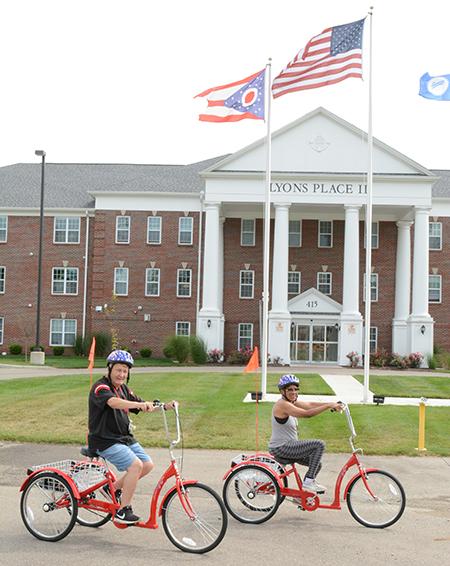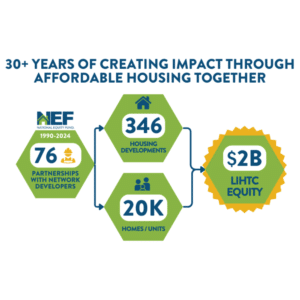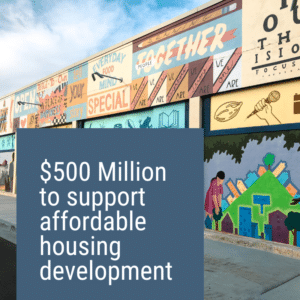The organizations NeighborWorks Capital (NC) serves have unique financing needs—particularly when it comes to predevelopment. More and more frequently, organizations are looking to borrow money well in advance of projects to keep their processes moving, and also face pressure to have some financing secured before being awarded tax credit dollars or similar funding. Historically, all of NC’s predevelopment lending has been unsecured term loans (typically around $300,000 to $400,000 for 1-3 years).
- Historically, all of NC’s predevelopment lending has been unsecured term loans (typically around $300,000 to $400,000 for 1-3 years).
- As organizations have started asking for larger predevelopment loans, NC sought some collateral to prudently lend on larger, $1-2 million loans.
- NC is working with customers on arrangements that involve pledging real estate assets or estimating against the timing and likelihood the organization will receive tax credits (dependent on region).
- In many of these cases, we have accepted collateral that do not fully secure the loan, meaning they aren’t sufficient to pay back the loan but do show good faith that the organization will do so and provide some leverage to NC should problems arise.
“Even years after the Great Recession, traditional banks continue to be gun shy about loaning unsecured money to real estate developers. The amount from NC combined with our size is something you’d have a hard time finding with a traditional bank. Anything over $400,000 is not going to just come ‘on your good name,'” said Wesley Young, Vice President & Chief Real Estate Officer at St. Mary Development Corporation.
When Young was looking for more capital, especially predevelopment capital, for bigger projects, he said his relationship with CEO Jim Ferris and the NeighborWorks Capital staff was important in learning about the line of credit product, as was NC literature and an NTI reception he attended.
“To meet certain requirements ahead of tax credit deals closing, we needed more capital. Having the line of credit gives us more flexibility to do more deals,” said Young.“While we have reserves, we don’t have to access them to do multiple deals. This allows us to do more and have liquidity while preserving our reserves,” he said of St. Mary’s line of credit with NC. “An LIHTC closing is a long process. The line of credit makes it very easy to work with the required time frame.”
St. Mary, which has a $1 million line of credit with NC, has drawn about $300,000 on its line of credit for McBride Place (named after St. Mary’s founder, Richard McBride), 64 affordable apartments with a preference for veterans. It will be built as an expansion of St. Mary’s first development, Lyons Place II, on the Veterans Affairs campus in Dayton, Ohio, which serves six counties and 38,000 veterans.

In Kingston, NY, NC worked with RUPCO to create a $1.5 million predevelopment line of credit with a $750,000 project limit, secured by a residential building, which has helped RUPCO expand its real estate development pipeline from one project at a time to several.
“Right now, the need for affordable housing is great, especially for seniors, and the state of New York has more funding than ever for these projects,” said Kevin O’Connor, RUPCO’s CEO. “We have taken on more real estate development and added staff. The line of credit has proven to be very important to help us handle the predevelopment costs and not affect our operating costs as well.”
With five business lines, the line of credit has helped fund predevelopment expenses including environmental studies, legal, consultants, architects and engineers, O’Connor said.
Hispanic Housing Development Corporation (HHDC)’s pipeline of projects and solid history as a developer in Chicago made them a good fit for a line of credit. Working with HHDC, we created a flexible product that takes into account the nature of HHDC’s projects. The $10 million line of credit with $4 million for predevelopment funding is secured by two commercial buildings. The line of credit is split, so it can be targeted to rental properties they acquire on the open market and preserve affordability as well as new construction.
“It’s different from a bank. A bank looks at the value of a property on the open market, and secures their loan on the value of the mortgage of the property. The NC line is not secured by a mortgage. As long as we have a well thought through plan and reasonable expectations to pay off the line of credit draw, it gives us greater ability to acquire property or land,” said Stephen Porras, Vice President of Development at HHDC. NC requires a development plan for draws that includes a schedule, project financing, and sources for the takeout. “I welcome the process, because it is a check on our own thinking as a developer. If we don’t have a plan for how to get construction started and be able to pay back acquisition loans, reimburse, etc., then that’s not good business. It’s a reasonable process, and well worth the effort.”











